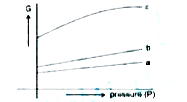Given C+2S→CS2,ΔHf0=+117.0KJmol−1,C+O2→CO2,ΔHf0=−393.0KJmol−1S+O2→SO2,ΔHf0=−297.0KJmol−1. The heat of combustion of CS2+3O2→CO2+2SO2 isSolution in Telugu
−807KJmol−1
−1104KJmol−1
+1104KJmol−1
+807KJmol−1
The correct Answer is:B
Step by step video, text & image solution for Given C+ 2S rarr CS_(2), DeltaHf^(0) = +117.0 KJ mol^(-1), C + O_(2) rarr CO_(2), DeltaHf^(0)= -393.0 KJ mol^(-1) S + O_(2) rarr SO_(2), DeltaHf^(0) = -297.0 KJ mol^(-1). The heat of combustion of CS_(2) + 3O_(2) rarr CO_(2) + 2SO_(2) is by Chemistry experts to help you in doubts & scoring excellent marks in Class 12 exams.
Topper's Solved these Questions
- BOOK - AAKASH SERIESCHAPTER - CHEMICAL THERMODYNAMICSEXERCISE - Practice Sheet- Exercise-III30videos
CHEMICAL THERMODYNAMICS
- BOOK - AAKASH SERIESCHAPTER - CHEMICAL THERMODYNAMICSEXERCISE - Practice Sheet- Exercise-IV20videos
CHEMICAL THERMODYNAMICS
- BOOK - AAKASH SERIESCHAPTER - CHEMICAL THERMODYNAMICSEXERCISE - Practice Sheet-Exercise-I33videos
CHEMICAL THERMODYNAMICS
- BOOK - AAKASH SERIESCHAPTER - CHEMICAL KINETICSEXERCISE - Objective Exercise - 4 (Assertion (A) & Reason (R) Type Questions)44videos
CHEMICAL KINETICS
- BOOK - AAKASH SERIESCHAPTER - CHEMISTRY IN EVERY DAY LIFEEXERCISE - PRACTICE EXERCISE29videos
CHEMISTRY IN EVERY DAY LIFE
Similar Questions
The following curve represents the variation of Gibbs function 'G' with pressure at constant temperature. Correct match of given plots with the physical state of a substance is
 05:42View Solution
05:42View SolutionFor a perfectly crystalline solid Cp.m=aT3, where a is constant. If Cp.m is 0.42 J/K − mol at 10K, molar entropy at 10K is
11:38View SolutionWhich of the following diagram correctly represents the variation of internal energy (U) of gas under expansion at constant temperature.
04:44View Solution(A) Spontaneous reaction may be slow or fast.
(R ) Spontaneous nature deals with feasibility of the reaction but not rate.01:46View SolutionAnti allergy drugs are
02:03View SolutionFrom the data at 25^(@)C : Fe_(2)O_(3)(s) +3C_(("graphite")) rarr 2Fe(s) + 3CO(g), DeltaH^(Theta) = 492.0 kJ mol^(-1) FeO(s) +C_(("graphite")) rarr Fe(s) CO(g), DeltaH^(Theta) = 155.0 kJ mol^(-1) C_(("graphite")) +O_(2)(g) rarr CO_(2)(g), DeltaH^(Theta) =- 393.0 kJ mol^(-1) CO(g)+(1)/(2)O_(2)(g) rarr CO_(2)(g), DeltaH^(Theta) =- 282.0 kJ mol^(-1) Calculate the standard heat of formation of FeSO(s) and Fe_(2)O_(3)(s) .
02:08View SolutionThe standard Gibbs free energies for the reaction at 1773K are given below:
C(s)+O2(g)→CO2(g),ΔGΘ=−380kJmol−1
2C(s)+O2(g)⇔2CO(g),ΔGΘ=−500kJmol−1
Discuss the possibility of reducing AI2O3 and PbO with carbon at this temperature,
4AI+3O2(g)→2AI2O3(s),ΔGΘ=−22500kJmol−1
2Pb+O2(g)→2PbO(s),ΔGΘ=−120kJmol−107:29View SolutionGiven C+2S rarr CS_(2), DeltaHf^(@)=+117.0 kJ mol^(-1) C+O_(2) rarr CO_(2), DeltaHf^(@)=-393.0 kJ mol^(-1) S+O_(2) rarr SO_(2), DeltaHf^(@)=-297.0 kJ mol^(-1) The heat of combustion of CS_(2)+3O_(2) rarr CO_(2)+2SO_(2) is
02:32View SolutionConsider the following reactions at 1000^(@)C . (A) Zn_((s))+1/2 O_(2(g)) rarr ZnO_((s)), DeltaG^(@)=-360 kJ/mol (B) C_("(gra)")+1/2 O_(2(g)) rarr CO_((g)), DeltaG^(@)=-460 kJ/mol correct statement at 1000^(@)C is
03:40View SolutionThe enthalpy change for the following reactions are:
Cdiamond+O2(g)→CO2(g) ΔH=−395.3KJmol−1
Cgraphite+O2(g)→CO2(g) ΔH=−393.4KJmol−1
The enthalpy change for the transition
Cdiamond→Cgraphite will be :View SolutionIn the reaction :S+32O2→SO3+2xkJ and SO2+12O2→SO3+ykJ heat of formation of SO2 is
03:44View Solutionदिया है -
C+2S→CS2,ΔfH∘=+117.0kJmol−1
C+O2→CO2,ΔfH∘=−393kJmol−1
S+O2→SO2,ΔfH∘=−297kJmol−1
CS2 की दहन ऊष्मा
[CS2+3O2→CO2+2SO2] है -02:52View SolutionC+O_(2) rarr CO_(2), Delta H =-396 kJ mol^(-1) . Heat liberated in formation of 0.154 kg of CO_(2) is
02:38View SolutionIf the standard formation- enthalpy of CS2,CO2 and SO2 are 117kJ⋅mol−1,−393kJ⋅mol−1 and −297kJ⋅mol−1 respectively , calculate the standard reaction enthalpy of - CS2+3O2→CO2+2SO2
03:10View SolutionGiven: C+2S→CS2,ΔH=117kJ
C+O2→CO2,ΔH=−393kJ
S+O2→SO2ΔH=−297kJ
The heat of combustion of CS2 to form CO2 and SO2 is02:38View Solution

